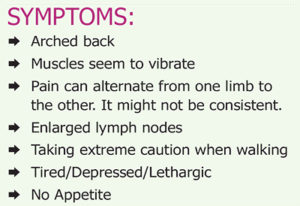
While the hope is that your dog never has to worry about these types of diseases, the truth is our four-legged pals tend to be adventurous. Sometimes they stick their adorable little snout where they shouldn’t.
I only learned about lyme disease firsthand when adopting an eight year old retriever named Duke. In Duke’s case, a tiny tick felt like taking a ride on his back and gave him this disease in return.
I never worried about Lyme since I had moved from New York where there are plenty of ticks to Las Vegas, where there are virtually none. Yet, anything is possible, including Lyme disease!
Like most dog owners, I’m familiar with their personalities, their expressions, etc. Even though each dog is different, I have a good idea of how they should behave at certain ages. Duke was eight years old, but by the looks of him, you would’ve thought he was fifteen. He slowly walked to my car, his back arched, his gait slow and careful. His pain seemed to switch from limb to limb. While some may argue that dogs don’t get depressed, that was all I could see in his eyes. Thankfully, after numerous tests, a diagnosis was made.
 These are some symptoms associated with Lyme. As with many diseases, they could also be indicative of another illness as well.
These are some symptoms associated with Lyme. As with many diseases, they could also be indicative of another illness as well.
While there is no absolute cure, you can put it in remission with hopes that it will remain there. The necessary remedy is an antibiotic. Your veterinarian will give you the prescribed dosage. Your dog might also need pain pills and a non-steroidal anti-inflammatory(NSAID). If your pooch is not eating, you might want to inquire about a liquid form.
Since Lyme disease can cause kidney damage, you may want to talk to your vet about testing for that.
When Will Their Conditions Improve?
The answer generally is this. “It’s a marathon, not a sprint.” It could take up to six weeks, or in some cases, even longer.
Consider it a work in progress. During the first week or so, you might only notice slight improvement in appetite. Mobility might not be much better. Hopefully by week two or three, their energy will increase and they will show a bit more interest in food.
It is helpful to keep a journal of their progress. If you notice that they are improving a bit each day, that is a good sign, but if they are still not eating or able to walk, you may want to schedule an appointment with your veterinarian.
The pain they are going through is intense. Most dogs try to mask their pain, so the fact that you can SEE how much pain they are in shows how horrible they must feel. Let your dog relax in a comfortable, quiet environment.
If your dog is diagnosed with this frustrating and painful disease, take your time with your dog. It can be an extremely slow process. Keeping track of their progress will allow you to mark their improvement and hopefully, within a few weeks, they will be on their way to recovery. In Duke’s case, it took him almost eight weeks to recover! ©
Elizabeth Parker – Author of Finally Home, Final Journey, My Dog Does That!, Bark Out Loud!, Paw Prints in the Sand,Paw Prints in the Sand: Mission Accomplished, Unwanted Dreams, Phobia, Evil’s Door and Faces of Deception. Available on Amazon.com!
